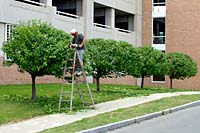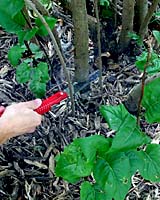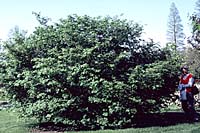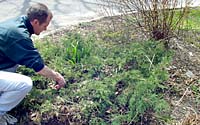Terry L. Ettinger Horticulture Consulting Services
Meeting The Needs Of Today With A Vision For The Future
Landscape and
Lawn Management Services
Pruning Recommendations
 Questions relating to the pruning all types of
plants are easily among the most common that I
receive from callers to my radio and television programs - and from
clients, too.
Questions relating to the pruning all types of
plants are easily among the most common that I
receive from callers to my radio and television programs - and from
clients, too.
In my mind, there are four reasons for the frequency of pruning-related questions.
 First, we don't want to "hurt" a plant by pruning it.
Therefore, many of us (or at least our significant other) want a
high level of reassurance before making the first cut - such as
removing the one-third of the thickest, oldest stems of an overgrown
lilac right at the ground as soon as the plant has finished blooming
in May (photo at left). Fortunately,
in all but very extreme cases it's impossible to kill a plant by
pruning it - though long-term disfiguration can occur.
First, we don't want to "hurt" a plant by pruning it.
Therefore, many of us (or at least our significant other) want a
high level of reassurance before making the first cut - such as
removing the one-third of the thickest, oldest stems of an overgrown
lilac right at the ground as soon as the plant has finished blooming
in May (photo at left). Fortunately,
in all but very extreme cases it's impossible to kill a plant by
pruning it - though long-term disfiguration can occur.
It's also common for plants to suffer broken and/or damaged trunks, branches and stems. While this damage would go unnoticed in the middle of a forest, it's not exactly pleasant to look at - and at times may be downright dangerous when it occurs in one's backyard!
Plants also grow - often in "stealth" mode. What I mean by this is that I've talked with many people over the years that claim the shrubs across the foundation of their home grew to unmanageable proportions practically overnight! (Of course, what's really happened is that the individual and/or their significant other has simply ignored the situation for years, often out of fear of killing the offending plants by pruning them - or to go golfing.)
 Finally, and
in my opinion, the real reason that I get
so many pruning-related questions is that we simply don't understand
just how big various plants can become - especially when they start
out as cute little plants no more than a foot tall that we
inevitably plant next to our front door, off the front corner of our
home, or under a floor to ceiling picture window! In many, many
cases a primary offender in this category is `Compact' burning bush
which contrary to its name can grow fifteen to twenty feet tall and
wide (photo above, at right - my Mom can be seen just to the right
of this plant at the Missouri Botanical Garden in St. Louis,
Missouri).
Finally, and
in my opinion, the real reason that I get
so many pruning-related questions is that we simply don't understand
just how big various plants can become - especially when they start
out as cute little plants no more than a foot tall that we
inevitably plant next to our front door, off the front corner of our
home, or under a floor to ceiling picture window! In many, many
cases a primary offender in this category is `Compact' burning bush
which contrary to its name can grow fifteen to twenty feet tall and
wide (photo above, at right - my Mom can be seen just to the right
of this plant at the Missouri Botanical Garden in St. Louis,
Missouri).
 As an International Society or Arboriculture
Certified Arborist (photo at left), I can help you develop a plan for pruning trees,
shrubs, hedges and other plants in your landscape.
As an International Society or Arboriculture
Certified Arborist (photo at left), I can help you develop a plan for pruning trees,
shrubs, hedges and other plants in your landscape.
 Just keep in mind that my recommendations may
occasionally include the removal of plants that pose a significant
hazard to people and/or structures - or simply can't be pruned in
manner that improves their appearance and/or health (such a
situation existed at our home where it became necessary to take down
a one hundred foot-tall red maple tree that was simply overwhelming
our driveway, home and garage, photo at right).
Just keep in mind that my recommendations may
occasionally include the removal of plants that pose a significant
hazard to people and/or structures - or simply can't be pruned in
manner that improves their appearance and/or health (such a
situation existed at our home where it became necessary to take down
a one hundred foot-tall red maple tree that was simply overwhelming
our driveway, home and garage, photo at right).